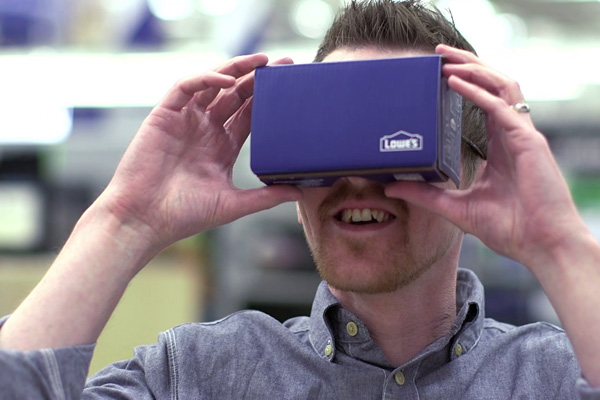
2016 is yesterday’s news! Check out our top Virtual Reality and Augmented Reality technology trends for 2019 and see what’s in store for the year ahead. For more information on how retailers are using mixed commerce solutions, check out our Mixed Commerce Glossary, which defines the terminology being used to businesses to describe the changes currently sweeping retail.
What are the top Virtual Reality and Augmented Reality technology trends for 2016?
2015 was a year of tantalizing promise for Virtual Reality and Augmented Reality technology, with plenty of new hardware announced and initial content forays hitting the mainstream. 2016 is shaping up as the year that promise is fulfilled, with previously drooled over hardware finally making its way into the hands of consumers, and exciting new content providing unique experiences to a public hungry to experience this new technology.
So where are Virtual Reality and Augmented Reality headed in 2016? Here’s our top 5 emerging trends:
1. Your first taste of Virtual Reality will probably be free
Consumers won’t have to pay for their initial AR and VR experiences. Sponsored experiences are driving initial desire and market adoption before VR headsets become a part of the average person’s tech arsenal. From the New York Times and ABC News to “Star Wars” and the Lowe’s Holoroom, we will continue to see big media, entertainment and retail brands test the limits of VR and AR tech with sponsored experiences that reach millions of consumers and expose unlikely audiences to Virtual and Augmented Reality. And it will be free for now.
Gartner analyst Brian Blau believes that the public will be very interested in paying for high-quality Virtual Reality and Augmented Reality experiences. “When they put it on you can just really see the light bulbs go off,” Blau said in a recent interview with NPRs Laura Sydell. “They get it right away within the first minute or two they turn their head around. They instantaneously realize, like, ‘Wow! I am transported.’”
2. The AR and VR hardware war is on! Augmented Reality technology struts its stuff with HoloLens
Over the past few years, hardware has dominated the conversation around Virtual Reality and Augmented Reality. There have been big ideas and slick gaming demos, one notable failure (Google Glass) and a lot of crazy weird entries to the category. There have been recent daring investments in mysterious companies like Magic Leap, and the gobbling up of intellectual property by behemoths like Google, Facebook and Apple. 2016 promises major new releases, including the Facebook-owned Oculus Rift (now available though very hard to find), the HTC Vive, Microsoft HoloLens, and branded headsets to pair with Sony PlayStation 4 and Microsoft Xbox One. Many of the new units are pricey (Oculus is $599, the Vive is $799, and the HoloLens will set you back a hefty $3,000), but there are other hardware options now available at a more accessible price point. Samsung GearVR runs a remarkably affordable $99.99, and recent promotions saw GearVR being given away with the purchase of a Galaxy S7 smartphone. Google Cardboard can be yours for as little as $1.50 (or even free in some cases), the low price helping Google move more than five million Cardboard sets into the hands of consumers.
3. Where’s the beef? Augmented Reality and Virtual Reality content gets serious
All of these devices hold so much promise, but consumers are left holding the bun so to speak. Without content, VR devices are less useful than a a loaf of bread.
To ensure that consumers don’t get frustrated by a lack of content, device makers are highly motivated to encourage content creation and development when it comes to games, media, user generated content and even retail shopping experiences.
Welcome to 2016, the year of Virtual Reality and Augmented Reality content for everyone. Without content, the fanciest VR headset is nothing more than a fancy paperweight. The conversation about AR and VR content has been happening behind the scenes, but it will start to take center stage In 2016.
The good news is that the number of applications is exploding — led by the video game industry. But if you believe that Virtual Reality and Augmented Reality are all about gaming and futuristic hardware, 2016 will be a good time to reboot your thinking. This year will be pivotal when it comes to the convergence of VR and AR content beyond entertainment, largely thanks to the accessibility of powerful new devices.
So far this year we’ve seen: YouTube go all-in on its 360 video channel, The New York Times and ABC News make forays into Virtual Reality newsgathering, Verizon’s AOL purchase startup RYOT to bring VR news to its Huffington Post property, the VR “movie” Allumette win rave reviews at the Tribecca Film Festival, and the Villanova Wildcats beat the North Carolina Tar Heels in the VR broadcast of the NCAA Final Four.
What remains to be seen is how all of this content will be streamed and where it will live.Oculus already has a rudimentary streaming site, can Netflix, Amazon Prime Video, Google Play, Apple iTunes and Hulu – and even traditional network and cable media players – be far behind? Look for 3D content channels, like YouTube 360, to join and infiltrate the ranks of the streaming media giants.
4. VR and AR are changing pro sports
Pro sports has always been on the leading edge of AR and VR – exemplified by the first down line and the very early hockey puck glow, some of the first uses of Augmented Reality during live broadcast. The future of sports for both athletes and spectators is firmly rooted in Virtual Reality and Augmented Reality. Literal game changers, VR and AR are going to allow for better training, advanced analytics, and a spectator experience that makes today’s HD broadcasts seem positively quaint by comparison.
Teams like the Dallas Cowboys and Tampa Bay Rays are already using VR and AR systems to aid in training. Cowboys head coach Jason Garrett spoke glowingly about the technology, telling ESPN, “This allows you to get a little closer so you can coach better.”
And it’s not just on-field performance NFL teams are after. Recently, the league began exploring the use of VR in diversity training.
As for all us couch-bound fans, the way we view a sporting event is already changing. This year’s NCAA Final Four was live streamed in VR via the NCAA’s March Madness Live VR app, as was the 2015 U.S. Open golf tournament. Teams and broadcasters are looking at ways to present their products to the masses using VR/AR. Cleveland Cavaliers owner Dan Gilbert sees a day when fans can purchase courtside seats by the thousands and tune in via a VR headset for the ultimate spectator experience.
“I want you to think about an arena that has 20,000 seats and your limiting factor is no matter how many people want to come to that game, you can’t sell any more seats,” Gilbert says. “Now you can put these 3D things on and sit, and sell a seat, at center court.”
5. Hollywood is giving AR and VR their first real close up
Movie and TV studios are always looking for new ways to hype their upcoming slate, and Virtual Reality and Augmented Reality tie-ins are quickly becoming a common part of the marketing blitz. Fox’s “The Martian” already set the gold standard in VR-movie advertising with a stand-alone adventure that put the viewer in the shoes of Matt Damon’s marooned astronaut. Later this year, “Ghost in the Shell,” “Assassin’s Creed,” the “Independence Day” sequel and others will arrive with a full VR or 360 video experience plugging their impending release.
But advertising is only the beginning. All the major studios are investing heavily in Virtual and Augmented Reality, and early experiments in VR storytelling are generating rave reviews from audience and critics alike. This year’s Tribeca Film Festival highlighted Virtual Reality entertainment, and showcased “films” across genres, including documentary (“The Artists of Skid Row”), concert film (“Grateful Dead: Truckin’”), graphic novel adaptation (“Sens”) and even a VR Christmas movie starring Seth Green (“Holidays: Christmas VR”).












